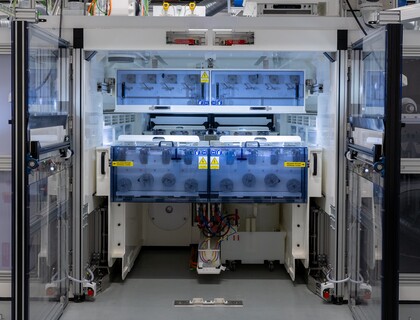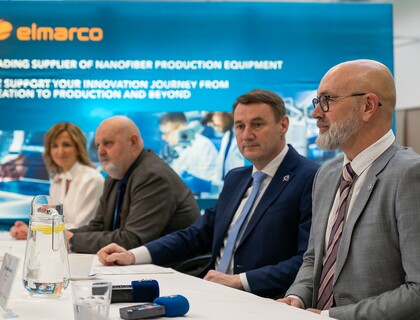
WEBINAR RECORDING: Electrospinning and Ultrasonic Coating of Fibers with Nanoparticles for Medical Applications

Join us at Elmarco Talks where you'll gain valuable knowledge, interact with thought leaders, and connect with a community of professionals passionate about nanofibers and their applications.
What will be discussed?
Fibrous scaffolds produced by electrospinning can mimic the structure of natural ECMs in humans to a great extent and thus open the wide territory of new medical applications. Electrospun fibrous structure characterize with high porosity, pore connectivity, a large specific surface area and biocompatibility, which provide a good microenvironment for cell growth, differentiation, and proliferation on the surface. To improve the properties of electrospun scaffolds we invented and patented the new non‑destructive method of inorganic particles (such as nanohydroxyapatite) deposition on fibers which give a variety of new improved functions to the material (high wettability, unique surface nanotopography, improved cells proliferation, antibacterial properties). As a result of our work we created, patented, and transferred to the cleanroom production the world’s first electrospun periodontal membrane with fibers ultrasonically coated with the nanohydroxyapatite. Material with superior functions will soon enter clinical trials phase on humans in collaboration with the industrial partner.
About the speaker
 Julia Higuchi, PhD Eng. MBA
Julia Higuchi, PhD Eng. MBA
Graduated from the Faculty of Medicine of the Medical University of Warsaw in the field of dental materials in 2011 and the Faculty of Materials Science and Engineering of the Warsaw University of Technology, in a field of biomaterials in 2014. Obtained an MBA at IPI PAS/Woodbury School of Business (USA) in 2019. Her PhD (2021) in Materials Science and Engineering at Warsaw University of Technology focused on electrospinning and surface modification of fibers with bioactive nanoparticles for medical use. Currently, Assistant Professor in Institute of High Pressure Physics PAS in Laboratory of Nanostructures. Her research focus is electrospinning, materials surface modification and transferring technology from the lab scale to the cleanroom production line according to ISO 13485 standards.
About Laboratory of Nanostructures Institute of High Pressure Physics (Polish Academy of Sciences)
The Institute of High Pressure Physics of the Polish Academy of Sciences is recognized worldwide for its unique expertise in the crystallization of bulk gallium nitride (GaN) crystals, epitaxy of nitride semiconductors, the fabrication of biomaterials, the study of soft matter and glasses, the physics of terahertz radiation and other materials science‑related fields. Institute also develops and manufactures high‑pressure equipment for research laboratories around the world.
Laboratory of Nanostructures in IHPP PAS specializes in the high‑pressure synthesis and characterization of nanomaterials. One of the flagship materials obtained in our laboratory is GoHAP™ - synthetic nanohydroxyapatite that mimics the natural mineral component of bone. This material has wide applications in medicine. Thanks to synthesis by using the high‑pressure reactors designed and build by our team, it is possible to obtain a material almost chemically identical to natural bone apatite as well as other nanoparticles (ZnO, ZnOAgCu, TiO, ZrO2). We use our solutions to synthesize nanopowders of the highest quality: ultra‑pure, phase‑homogeneous, with precise morphology and particle size. Our patented nanohydroxyapatite (GoHAP™) is produced under strictly controlled Class 7 and 8 cleanroom conditions according to ISO 13485:2016 (Medical Devices - Quality Management System). This ensures adequate purity and reproducibility of the manufacturing process material and certification for its use in humans. The GoHAP™ material is also being used as a product for deposition of layers on materials or forming solid implants with complex 3D structures.


